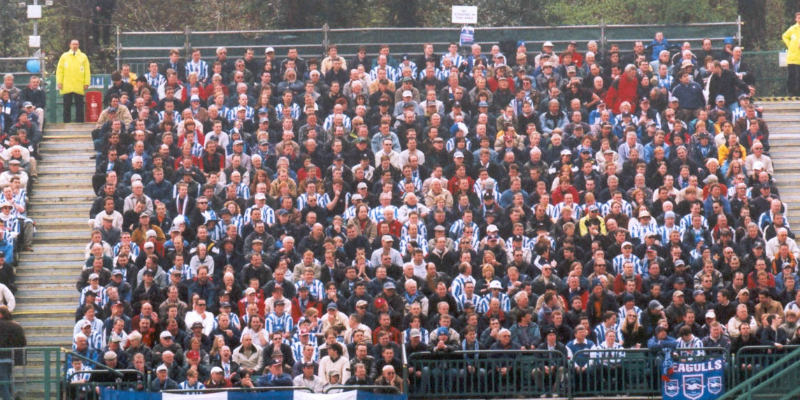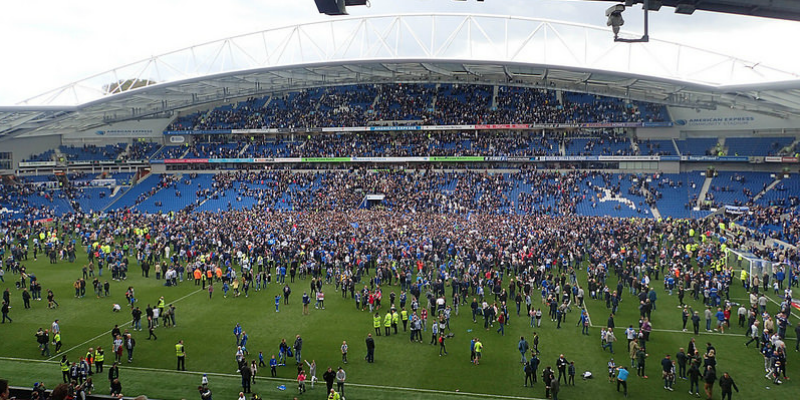Strictly speaking my hobby began in May 1969, but it didn’t fully flower until 1997, when Robbie Reinelt scored the equaliser at Edgar Street, Hereford, to keep Brighton and Hove Albion in the football league on the last day of the season, while I paced up and down my living room, getting increasingly agitated, tired and emotional, listening to the commentary on Radio 5.
Back in 1969, as an eleven year old, my first visit to the Goldstone Ground was made with a school mate and our younger brothers. We walked the two miles down the Old Shoreham Road on our own. This was long before the modern concerns about ‘stranger danger’. Back then, if we are honest, all small boys followed the local (third division) side but we all ‘supported’ a First Division club (and had the merchandised school bag to prove it – mine was white with blue and gold; some readers will be able to identify the club). In the ensuing years I was an irregular attendee at The Goldstone, always largely silent (‘chanting’ was for the vulgar types) apart from involuntary oohs and ahs. My club reached the FA cup final in 1984, while I was away in Vancouver completing my PhD but, from then on, apart from one last hurrah (a Wembley playoff final against Notts County, managed by Colin something, which I attended), we started a slow decline into chaos. Eventually in the Spring of 1997, we were 12 points adrift at the bottom of the fourth tier, and a corrupt owner had sold the Goldstone Ground without making any plans to build a new stadium. I attended a few home games, and was shocked by it all. One, against Hartlepool, became known as Fans United, when the fledgling internet chat forum, North Stand Chat, run by a fan, Gary Crittenden, became the focus for organising a protest. From a suggestion by another Albion fan, Warren Chrismas, which was picked up by a young Plymouth supporter, fans of clubs nationwide (and overseas) arranged to turn up to the Hartlepool game wearing their club shirts (unheard of back then) to show support for The Albion. It was extraordinary. We scored 5 goals, too.
We survived in the fourth tier thanks to a surprisingly good home record, and on goal difference – boosted in part by the Fans United game. And that’s when my hobby really began. With no ground of its own, the club started a ground-share with Gillingham. Although this was a nightmare for most Brighton supporters, it was a boon to me, because I live only 30 minutes’ drive from the (ghastly) Priestfield Stadium in Gillingham.
I went to the first competitive match there, a League Cup game. Only one stand was opened, and the awfulness is almost unbearably difficult to describe. Our once proud club was now bereft of a home. Only real die-hards were going to engage. Without planning to do so, I found myself turning up to every home game, having previously been a two or three games a season man. We were truly awful by then. Our better players had long gone, and if three consecutive passes were strung together this warranted applause. That first season was terrible, and we ended up with fewer points even than the season before when we almost dropped into the semi-professional Vauxhall Conference. However we survived again, thanks to the shambolic results of an even worse Doncaster Rovers who were owned by a complete crook who was eventually gaoled for paying a criminal to burn down the club’s own main stand in an insurance fraud.
By the second year of the Albion’s exile, I had discovered the Seagulls Mailing List (internet forum) and had started going to away games. I met lots of new people (some who are still chums, 20 years later). We had car shares to far flung places such as Carlisle, Exeter, Torquay and even Hull on a Tuesday night. I started to become vocal at games. I must say, absolutely losing your composure and deportment at the football is a quite heavenly feeling, and the crosser you get when things are going bad, the more exultant the feeling when you start winning.
The club moved back to Brighton in 1999, and I bought a season ticket. The travel went from trivial to irksome (180 mile round trip for me for home games) but it was worth it. For many years my teenage son was my companion. He’s not the world’s most forthcoming bloke, but our football days remain cherished. The first photo shows the South Stand at Withdean in 2000 with me and my son identifiable. In the Spring of 2001, the almost unthinkable happened, and a win away at Plymouth sealed a promotion back to the third tier, our traditional level, with the club ending the season as Champions. I was at Plymouth’s Home Park that day, and it is one of my most sublime footy moments. Then the club did the almost absurdly unthinkable and finished the following season as Champions of the third tier, and entered the second tier for only the fourth time in its history.

In the ensuing years we bounced back and forth between the second and third tiers, while Dick Knight, who had replaced our corrupt owner in 1999, poured money into the club. For a few years I contributed a column to a Fanzine, ‘Scars and Stripes’, edited by Darren Mackay, who now curates the web fansite ‘North Stand Chat’. It was all tremendous fun, but we needed a proper stadium if we were to be sustainable as a club. There was a great deal of Nimby opposition to the club’s plans, but with extraordinary campaigning by many people, the club eventually obtained permission to build the Brighton and Hove Community Stadium (commonly known as The Amex). After fourteen years without a proper home, in 2011 we combined another promotion (into what is now known as The Championship – division two in old money) with a move into our lovely new stadium. Dick Knight, although wealthy, sold the club to Tony Bloom, a lifelong fan and son of a former shareholder, who is apparently minted. He paid for the stadium build, and has pumped vast sums into the club. He is a true fan and is often seen travelling to away games on the train with fellow supporters.
Under Mr Bloom the club has slowly built itself up into what it is now. In 2017 we did what we had done only once previously in the club’s history, that is we gained promotion into the first tier (the Premier League). The second photo shows the lovely Amex stadium with supporters on the pitch celebrating the promotion.
We are now in our second year in the division, and keeping ‘under the radar’ (that way we hang on to our better players). We were tipped for an immediate return to tier two, but so far we have been reasonably comfortable, staying in the division with points to spare in the first season, further progress this season, sell out 30,000 crowds at every home game, with some epic wins (against Manchester United twice, for example). For a while I had to pinch myself. But it really is really real.

In the 20 years since Robbie scored the goal that kept us alive, I have had the most amazing time following my club. I remember going to London Road, Peterborough, for a third tier match about 15 years ago, and finding myself sitting next to Norman Bowery (R.I.P) and his wife. Apparently Norman’s wife was the original fan of the two, and Norman got the bug after doing what a lot of partners find themselves doing – coming along to games to avoid spending Saturday afternoons on their own. I have met loads of people through the unofficial fan sites, many of whom I now count as friends. We have had end-of-season ‘Internet Seagulls/Flying Squad’ gatherings going back two decades (I went to the first, in Shrewsbury, and the most recent, in Liverpool in 2018). I have had countless road trips with numerous newfound chums, and thousands of hours of enjoyment, shouting at referees, singing silly songs, living and reliving moments, all of which are these days summarised each week on ‘Match of The Day’. A far cry from the ‘football league roundup’ and 30 seconds of grainy highlights in the wee hours of the morning on channel Z, as it used to be 20 years ago. My club has gone from the gutter to the stars, and the journey has been divine. Long may it continue. It’s a hobby, and I am often hoarse.
Comments
If you are a British Pharmacological Society member, please
sign in to post comments.